Customer Churn Prediction with the Use of AI and ML
- PublishedLast update
- 5 min reading
One or two negative experiences are often enough to drive customers away. While some level of customer churn is inevitable for any business, effectively managing its prediction is critical to sustainable growth and secured profits. This is where artificial intelligence algorithms prove invaluable. Here is a comprehensive guide to effective customer churn prediction with the use of AI.
What is customer churn and how does it differ from revenue churn?
Customer churn rate refers to the percentage of customers you lose in a given period of time. Revenue churn rate refers to the percentage of revenue you lose in a given period due to customer churn.
Achieving a 0% churn rate is highly unlikely because there will always be factors that cause customers to leave, even in the presence of an exceptional product, service, and brand. The desired churn rate, or target, often varies depending on the industry and the size and maturity of a particular organization.
What is customer churn prediction?
Churn prediction is the process of anticipating which customers are likely to leave your brand, primarily based on their interactions with your product or service. To accurately predict churn, it's essential to collect and apply key markers identified by your tools (for example, loyalty management software) that indicate when a customer is about to say goodbye. This proactive approach allows you to intervene effectively, such as identifying broader patterns of customer churn
Why is customer churn prediction important?
In short, customer churn rate is a reflection of both the earning potential of your company and the power of brand loyalty. It serves as a clear indicator that there may be a problem that requires to be solved or a service/product that needs to be improved.
Unlocking the potential of churn prediction enables you to proactively retain your customer base, a strategy that is often far more cost-effective than constantly acquiring new customers.
But predicting churn is more than just identifying at-risk customers – it's about digging into the root causes that drive customer churn to increase retention and satisfaction across the board. By mastering the skill of predicting and preventing churn, you open the door to significant revenue growth opportunities.
Reduce Churn with Tailored Retention Offers
Losing customers? Not on MAIA’s watch. Our AI-powered loyalty assistant helps you spot at-risk members early, so you can act fast with the right reward or offer. It’s a win-win: your churn rate drops, and your customers get more personalized experiences. Watch the video to see how it works.
Customer churn rate by industry
Annual churn rates of 5% to 7% are ideal for mature and established companies. However, before calculating and acting on your specific churn rate, it is important to take a closer look at industry benchmarks. Why? There's no point in comparing your brand's performance to those that specialize in something completely different... since churn rates are very industry-specific, while the ideal zero churn rate is unrealistic.
| Industry | Telecoms | SaaS | Subscription (streaming services) | Banking | Retail |
| Churn rate (annual) | 30-35% | 32-50% | 37% | 19% | >51% |
Telecommunications
Telecoms experience relatively high annual customer churn rates between 30% and 35%. This is because customer loyalty to telcos dropped by 22% after the pandemic, with customer retention more than ever influenced by the customer experience. In addition, users are now more price-sensitive, with 58% considering telco services as expensive.
SaaS
Woopra states that the average annual customer churn rate for software-as-service companies 32-50%. According to the 2023 Customer Success Collective report, the most common reasons customers voluntarily leave SaaS companies include: not achieving their desired results (44%), product limitations such as bugs or glitches (20%), too high a price (13.7%), and a better offer from competitors (5.3%).
Subscription
While there are a variety of subscription services with varying churn rates (e-commerce, meal kit businesses, etc.), focusing on streaming and the US customer base, the average is 37%, according to Statista. Additionally, the study points out that Gen Z and Millennials are about four times more likely to cancel their subscriptions than older cohorts.
Banking
The financial sector, with a customer churn rate of 19% according to Customer Gauge, is a particularly interesting case, as 56% of customers who have left a bank claim that their decision could be reversed if the right actions were taken. Women in this industry churn at a rate 10% higher than men, and unlike the subscription industry, middle-aged and older customers are more likely to churn than younger ones.
Retail
Winning the loyalty of shoppers is even more challenging with an average customer churn rate of more than 51% in the e-commerce space. MoEngage’s study showed that retailers experience the highest levels of customer churn within the first seven days of sign-up (20%) and after a free trial period (20%). In addition, nearly two-fifths of retailers (18%) reported increased churn rates following product returns.
How do you calculate customer churn rate?
Customer churn model
Calculating churn rate is possible using a customer churn formula. This requires knowing the number of customers lost during a given period and how many customers started out. You can calculate monthly churn rate, quarterly churn rate and annual churn rate with this simple formula:

For example, your monthly subscription brand started with 10,000 subscribers on the first day of the month. Over the next 30 days, you lost 100 subscribers. Your customer churn rate is 1%, which means you can expect to lose 1% of your subscribers each month.
Now that you know your customer churn rate, you can start looking for the answer to the “Why?” question. This is where things get more challenging. You can use a method called cohort analysis, which involves identifying trends among customers by categorizing them into different segments – for example acuisition or behavioral cohorts. A common application of cohort analysis is to mitigate churn, referred to as churn rate cohort analysis.
Using acquisition cohorts, you can identify when customers churn throughout the customer lifecycle. Conversely, behavioral cohorts provide insight into why customers churn, revealing the specific actions or behaviors that often lead to customer churn.
How AI can support customer churn prediction?
Churn prediction requires collecting large amounts of data from multiple sources and analyzing it extensively to identify patterns and trends. Such a task would take a significant amount of time if performed manually or with the use of software that doesn’t utilize the power of smart algorithms. In addition, human analysis is prone to error and involves formulating hypotheses, testing them, and drawing conclusions that can be influenced by bias.
Using solutions that utilize artificial intelligence to address this issue not only avoids many of these drawbacks and costs but also automates the processes of segmentation and cohort analysis, comparing databases and finding the reasons behind churn. What’s more, it can do it in seconds.
If you want a comprehensive solution that leverages the power of AI and ML, there are a number of different options available, including the Comarch Loyalty Marketing Platform, whose marketing data analytics is ideal for analyzing, predicting, and preventing churn, among other things. How does churn prediction with AI work?

4 steps to effective churn prediction with the use of AI
1. Setting the churn prediction goals
Using AI to predict reasons for churn only proves beneficial when there's a clear understanding of what you search for. In the database of your loyalty management software, you already have all the data to feed the customer churn prediction model. To determine the likelihood of each customer leaving, you need to answer 3 important questions:
- What does an active customer mean to you and your company? (For example: someone who makes a purchase once a month, once a year, etc.)
- How far in advance do you want to know if they will be active? (For example: quarterly, which means if the customer will still be active in 3 months or if they will leave.)
- How often do you want to update the forecast? (For example: monthly, this parameter is determined by your definition of the customer's activity from point 1).
2. Organizing a proper customer segmentation
There are many reasons why customers churn, and the key to finding out why is reliable customer segmentation. Based on the collected cases of buying behavior, demographics, and other categories of all customers, the AI churn prediction model will find the most similar cases and predict their likelihood of leaving. This allows you to build a segment of customers at risk of leaving in a given period of time.
3. Using datasets to reveal patterns
After analyzing your data to segment it, algorithms will identify customers who are likely to churn. These insights may reveal patterns. By uncovering these relationships, you can proactively address churn with existing customers and mitigate future occurrences. AI-powered solutions can also alert you in real time to potential customer churn risks, such as missed payments, which are indicators of declining customer interest that may not be readily apparent in individual churn prediction reports.
4. Assessing which customers are worth fighting for
Surely you have asked yourself at this point, is it worth it? Is it profitable to fight for every customer and give them points or discounts to keep the flame alive? You'll find the answer in the data again. If, using AI algorithms, you have already built a segment of customers who are at high risk of leaving based on churn rate, combine it with the segment of members with the highest customer lifetime value (CLV) or customers who belong to the highest tier. They are the most valuable to you and worth investing more in. Losing them will cost you the most.
5. Regular monitoring of AI churn prediction model
Use AI and ML alongside your chosen churn prediction model to identify current customers at risk of churn and simply observe what happens. You can use analyze historical or test data to validate the accuracy of your churn predictions. It’s possible to incorporate new customer data into your modeling efforts as your business develops. Last but not least, continually monitor your churn prediction models and adjust them as needed to ensure effectiveness.

5 Ways to Reduce Customer Churn with the Power of AI and ML
Effectively predicting churn is one thing, but algorithms can also help you take proactive steps to prevent customer churn when it occurs (even before your model indicates a problem):
Learn as much as possible about your customers
Use the full potential of AI-powered marketing data analytics tools to get a 360-degree view of all your customers and see if their interest in your brand is growing or diminishing. How are they shopping? What products or services are they interested in the most? How is your brand seen in customer feedback?
Provide educational resources and support
Customers may abandon your product if they feel they don't understand it or aren't getting the most out of it. Consider creating digital resource hubs, regularly updating blogs, and implementing educational email onboarding sequences to address this issue and retain customers. That's where AI-powered omnichannel marketing applications come in handy.
Be sure your target audience is the right one
Evaluate whether your marketing strategies and sales efforts are targeting audiences that are likely to derive maximum value from your product. Adjust your customer retention strategies to focus on customer segments that are better suited to your offerings. All of this is also available with the right data analytics solution.
Engage customers before they even start thinking about leaving
There are many ways to activate customers. You can send a simple message encouraging them to buy more by recommending their favorite products. Or, you can go a step further, and add an incentive in the form of a super limited time offer (a discount coupon for their next purchase). Again, you can easily automate these activities with AI-based marketing software.
Key takeaways
A thoughtful approach to customer churn prediction, whether through building your own model or going for a ready-to-use solution utilizing AI, allows you to identify the factors that contribute to potential customer churn and take appropriate action.
Choosing an out-of-the-box solution such as Comarch Loyalty Marketing Platform, which runs its churn prediction model on AI algorithms, makes these processes much easier and helps integrate predictive operations into other areas of loyalty management.
Interested in testing our solution in practice? Unlock free access to our Loyalty Marketing Platform demo to watch a special episode dedicated to winning back underperforming members and reduce customer churn rate with AI that explains how to segment customers, build re-engagement campaigns, and create revitalizing promotions and offers.
Want to elevate your business and boost loyalty through AI-powered hyper-personalization? Hit the link below to learn about it from our e-book.







